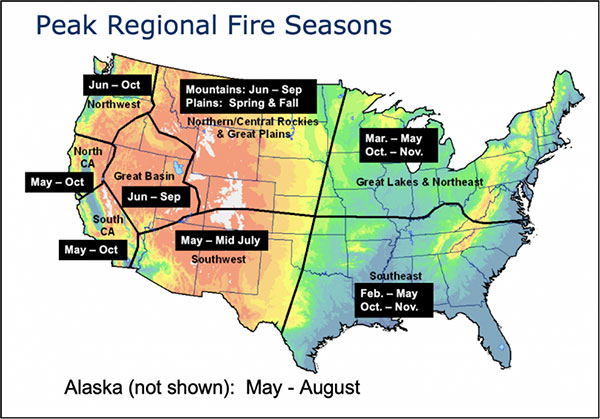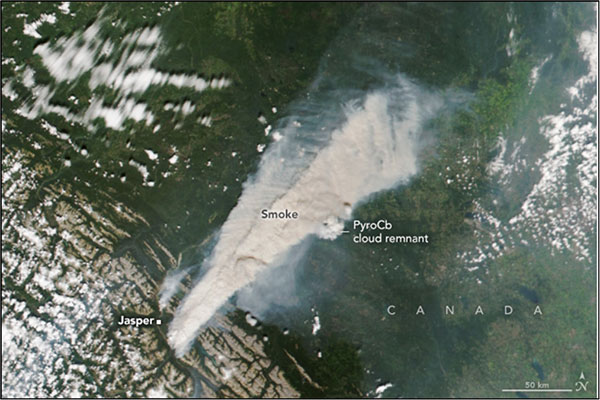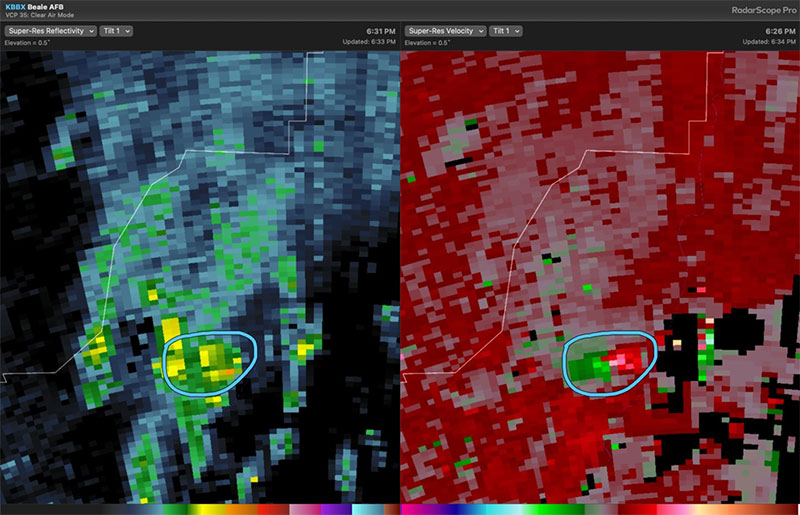The Challenge of Wildfires in North America.
Published: September 26, 2024
Summer in North America is a collision of extreme weather seasons. While the Atlantic and Pacific coasts brace for tropical weather threats, tornadoes endanger the U.S. Midwest, and heatwaves stretch across the continent and intensify the risk for drought and fire. Much of the Western U.S. and Canada’s wildlands cope with destructive wildfires each year— a hazard made more challenging by increasingly drier and hotter environments. The 2023 wildfire season was not only Canada’s worst on record, with an estimated 44.5 million acres of land burned, but one of the most severe across the world due to climate change-driven fire weather conditions (1). With another year of record-breaking heat and moisture deficits in 2024, wildfires in the U.S., Canada, and Mexico have already consumed an estimated 16.4 million acres (2).
Wildfire Seasons in North America
The timing of wildfire season in North America varies by nation and region; according to the U.S Department of Agriculture (USDA), wildfire season is generally defined by the average period between the containment of the first and last large fires (3). Different places experience their peak fire risk at different times of the year depending on climate conditions and weather patterns, with the dry and hot seasons often providing the fuel for more frequent and severe wildfires. Canada’s peak fire season tends to occur between May and September (4), while Mexico generally sees the majority of their wildfires in mid-March through May. Each region in the U.S., including Puerto Rico, has a different peak fire season. The dry season in Puerto Rico varies by geography, where some areas experience heightened fire risk beginning in January and lasting until May, while the southern region remains generally dry year-round (5). Over in the Pacific, Hawaii’s dry, fire-prone season tends to fall between April and October, with variations between the islands and their terrains. Each region in the continental U.S. also experiences peak wildfire activity at different times throughout the year (Figure 1).

However, a wildfire can begin virtually anywhere, at any time. The National Weather Service (NWS) issues fire weather alerts under their Red Flag Program, which includes a Fire Weather Watch, when critical fire weather conditions are possible; a Red Flag Warning, when critical fire weather conditions are ongoing or imminent, and an alert for Extreme Fire Behavior, when an ongoing fire is likely to “rage out of control” (6). The criteria that describe “critical” fire weather conditions include a combination of prolonged drought, dry fuels, high temperatures with low relative humidity, and weather events such as fronts and/or dry thunderstorms (i.e., low-precipitation thunderstorms) which provide high winds and a common ignition source— lightning. The NWS Storm Prediction Center (SPC) provides fire weather outlooks up to eight days in advance to forecast how likely a fire is to spread if one begins, on a scale from elevated to critical to extreme. To communicate the risk of ignition, these fire weather outlooks can correspond to the potential for isolated or scattered dry thunderstorms (7).
Wildfire Events in 2024
On February 26th, a downed powerline just north of Stinnett, Texas sparked what quickly became the largest wildfire in the state’s history. The Smokehouse Creek megafire scorched over one million acres between the Texas and Oklahoma Panhandles, claiming two human lives along with thousands of cattle (8). While this unprecedented blaze ignited during peak fire season in the grassy Southern Plains, its explosive growth into a megafire was aided by the unintended consequences of human management of the natural system: the overuse of fire suppression methods has allowed for invasive, woody species to flourish in the Southern Plains, creating conditions where fast-moving grass fires can become intense canopy fires. In addition, the influence of climate change on warming winters in this region, without a compensating increase of moisture, suggests higher evaporation rates, leading to drier fuels and allowing fires to intensify and spread at a quicker pace (9). As seasonal high winds also coincide with fire season, this region becomes increasingly vulnerable to critical fire weather and unpredictable fire behavior in the late winter and early spring (10). The Smokehouse Creek Fire consumed around 850,000 acres of land in only three days— a concerning example of how rapidly these fires can spread and outpace firefighting efforts, devastating large areas in a very short time.
On July 22nd, Canadian authorities received reports of wildfires to the northeast and south of the town of Jasper, Alberta, near Jasper National Park. Sparked by lightning, the fire reached the town within 48 hours, shortly after evacuations for the area ensued, including helicopter and boat rescues for backcountry hikers unable to evacuate on foot (11). More than 3,000 personnel worked to control the Jasper Wildfire Complex, the worst wildfire in a century in this location, as it burned over 80,000 acres, including one-third of the town’s structures. On September 7th, the Parks Canada agency declared the Jasper Wildfire Complex as under control and unlikely to spread further than the current fire perimeter, given the forecasted weather conditions and the continuous fire suppression efforts. This agency has also indicated that smoke and flames will likely persist within the fire’s perimeter until winter, raising the possibility of a holdover fire (12). Holdover fires — also known as zombie, hibernating, or overwintering fires — are increasing in the boreal forests of the northern high latitudes. These occur when active surface fires become subsurface fires beneath the snowpack, smoldering in the soil and within tree roots throughout winter, before reemerging in the spring when temperatures rise again. Holdover fires often occur earlier in the warm season than fires ignited by lightning or human activity. Once they regenerate, holdover fires can spread quickly, especially if the authorities have yet to detect them before the snow begins to melt (13).

When Wildfires and Weather Interact
When immense fire and heat interact with the atmosphere, it can unleash a suite of pyro-meteorological phenomena that are as fascinating as they are destructive. One of the most striking examples is the formation of pyrocumulonimbus clouds. As an intense wildfire, complex of fires, or a volcanic eruption occurs, the superheated air, smoke, and ash rapidly rise to cooler layers above, and with enough moisture present in the air, a massive, fiery thunderstorm cloud can form. As this pyro-convection happens, the surrounding air rushes to fill the empty space left behind and creates a self-sustaining updraft. Pyrocumulonimbus clouds can worsen ongoing fires and even start new ones nearby when they produce strong downdrafts that transport embers and spark spot fires, create cloud-to-ground lightning that ignites new fires, and even generate dangerous fire tornadoes in its updraft (14).
Earlier this summer, a wildfire began near Chico, California when a suspected arsonist pushed a burning vehicle into a ravine in Bidwell Park. What would become the extreme Park Fire has burned over 400,000 acres of land since July 24th and currently remains 99% contained. But on July 25th, this inferno gave rise to an apparent fire tornado as its powerful updraft began to rotate; although the NWS did not confirm this was a fire tornado, a significant velocity couplet did appear on doppler radar (Figure 3).

Final Thoughts
As wildfires continue to reshape communities and landscapes in North America, it is crucial to understand their dynamic relationship with weather. The potential for these fiery events to become more frequent and/or intense in our increasingly unstable climate urges the need for improved wildfire mitigation and suppression strategies that align with natural fire regimes, rather than disrupt them. Wildfires, like many natural processes of our planet, bring vitality to ecosystems by enriching the soil and sparking new growth in their aftermath. But striking a balance between allowing nature to run its course and protecting human communities requires a deep commitment to sustainable land-use management, so we can foster a greater resilience between nature and society as a whole.

